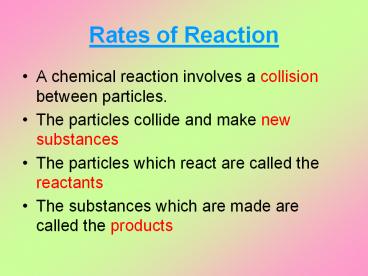Rates of Reaction - PowerPoint PPT Presentation
1 / 11
Title:
Rates of Reaction
Description:
Rates of Reaction A chemical reaction involves a collision between particles. The particles collide and make new substances The particles which react are called the ... – PowerPoint PPT presentation
Number of Views:126
Avg rating:3.0/5.0
Title: Rates of Reaction
1
Rates of Reaction
- A chemical reaction involves a collision between
particles. - The particles collide and make new substances
- The particles which react are called the
reactants - The substances which are made are called the
products
2
How do we make the reaction go faster?
- There are four things that we can change to make
the reaction go faster. - They are
- Temperature
- Surface area
- Concentration
- Using a catalyst
3
Temperature
- When we increase the temperature we give the
particles energy - This makes them move faster
- This means they collide with other particles more
often - So the reaction goes faster.
4
Surface area
- If we make the pieces of the reactants smaller we
increase the number of particles on the surface
which can react. - This makes the reaction faster.
The particles on the surface can react
When cut into smaller pieces the particles on the
inside can react
5
Concentration
- If we make one reactant more concentrated (like
making a drink of orange squash more
concentrated) - There are more particles in the same volume to
react - So the reaction goes faster.
There are less red particles in the same volume
so there is less chance of a collision
There are more red particles in the same volume
so there is more chance of a collision so the
reaction goes faster
6
Using a catalyst
- A catalyst is a chemical which is added to a
reaction. - It makes the reaction go faster.
- The catalyst does not get used up in the
reaction. - It gives the reaction the energy to get started
7
- Fill in all the gaps
- 1. A chemical reaction involves a ______between
particles. - 2. The_____collide and make new substances.
- 3. The particles which react are called the
- 4.The substances which are made are called the
- 5.There are _____things that we can change to
make the reaction go____. - 6.They are________, ________, _________ and
_________.
8
EXOTHERMIC AND ENDOTHERMIC REACTIONS
- Exothermic- heat energy EXITS the system
- ex. Combustion, evaporation of water
- - surroundings usually feel warmer
- An example of an exothermic reaction is the
mixture of sodium metal and chlorine gas which
yields table salt. - 2Na(s) Cl2(g) ---gt2NaCl(s) energy
9
Endothermic
- - heat energy ENTERS the system
- - ex. Cold packs, melting ice
- - surroundings usually feel cooler
- How do cold packs work?
- -The outer pouch contains water. The inner pouch
contains ammonium-nitrate. When you pop the
inner pouch, the chemical reaction absorbs heat
energy from the surroundings. This is an
endothermic reaction. - The temperature of the solution falls to about 35
F for 10 to 15 minutes.
10
Activation energy
- The minimum energy that reactant molecules must
possess in order for the reaction to start. - In exothermic reactions, products have less
energy than reactants. - In endothermic reactions, products have more
energy than reactants.
11
PRACTICE
- Give three examples of exothermic reactions in
everyday life. - Classify each reaction as exo- or endo thermic
- a.Photosynthesis
- b.Melting ice
- c.Sodium hydroxide dissolving in water and the
temperature of the solution rising. - d.Ammonium chloride dissolving and the
temperature falling.































